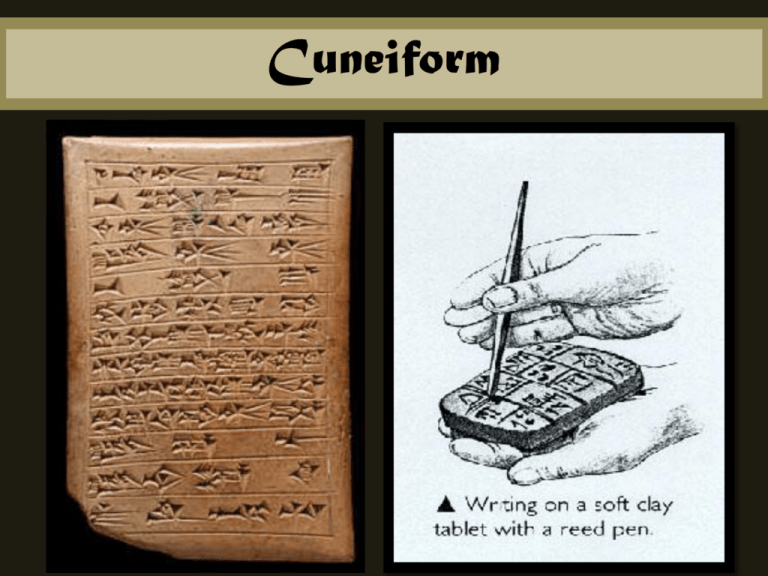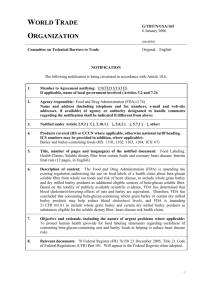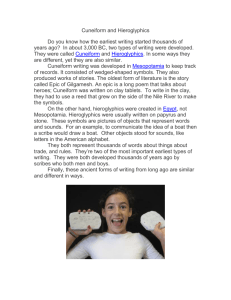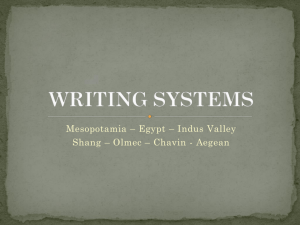Cuneiform
advertisement

Cuneiform The Legacy of Mesopotamia: Cuneiform • How many of you know what barley is? • How is it used? • What does it look like in its natural state? • The first Mesopotamian written representation of barley was a picture… The Legacy of Mesopotamia: Cuneiform • This is what barley looks like… • If you were going to make a pictogram of barley what would it look like? Our Barley Pictograms… The Legacy of Mesopotamia: Cuneiform • • • • What does picture writing do well? What advantages does picture writing have? What are its weaknesses? Can a pictograph convey what the word it is depicting sounds like? The Legacy of Mesopotamia: Cuneiform • What’s the relationship between the way our word “barley” looks and barley itself? • What are the elements of our word for barley • How do we know that the symbols which make up the word represent the grain? • The word “barley” is the phonetic representations of the sounds of the word as we say it that connect the written word to the concept. • In Mesopotamia “barley” was called “she” Let’s…Read About Cuneiform “Barley” • Around 3100 B.C. people began to record amounts of different crops. Barley was one of the most important crops in southern Mesopotamia and when it was first drawn it looked like this. “Barley” • The barley sign changed shape when the scribes used a writing tool with a squaredoff end instead of a point. • The end of this tool was used to press wedge shapes like these into clay tablets. The barley sign had to be written using several wedges. “Barley” • Another change was that the tablets were written so that all of the signs appeared to be lying on their side. “Barley” • Not only the shape, but also the use of the sign had been changing. The barley sign could now be used in two ways: – It could represent barley, as on this tablet – It could also be used to represent a sound. The Sumerian word for barley was 'she'. So the barley sign was used to represent the sound 'she' in a word. • For example, this tablet tells us about fig cakes given out from the temple. The Sumerian word for fig cake is 'she-er-ku'. 'She-er-ku' “Barley” • The barley sign was used for over three thousand years. The way that it looked and the way that it was used changed in many ways. • One of the last ever appearances of the barley cuneiform sign is on this tablet from 61AD. Other Examples of Evolving Characters: Head c. 3100BC c. 2800BC c. 2400BC c. 600BC Other Examples of Evolving Characters: Bird c. 3100BC c. 2800BC c. 2400BC c. 600BC Other Examples of Evolving Characters: Ox c. 3100BC c. 2800BC c. 2400BC c. 600BC Other Examples of Evolving Characters: Palm c. 3100BC c. 2800BC c. 2400BC c. 600BC Other Examples of Evolving Characters: Tree c. 3100BC c. 2800BC c. 2400BC c. 600BC How do we know what it says? • Knowledge of cuneiform was lost until AD 1835 • Henry Rawlinson, an English army officer, found some inscriptions on a cliff at Behistun in Persia. Carved in the reign of King Darius of Persia (522486 BC), they consisted of identical texts in three languages: Old Persian, Babylonian (cuneiform) and Elamite. • After translating the Persian, Rawlinson began to decipher the others. • By 1851 he could read 200 cuneiform signs. Behistun Inscription, The Persian Rosetta Stone Behistun Inscription, The Persian Rosetta Stone Behistun Inscription, The Persian Rosetta Stone Sir Henry Rawlinson, 1st Baronet To Review… • Cuneiform was first used to record what? • How did cuneiform evolve from pictograms to a phonetic language? • What is the benefit of picture writing? What is its weakness? Creating your own language • Count off by 3s… • Group 1: You will design a language based on pictographs • Group 2: You will design a language based on hieroglyphics • Group 3: You will design a language based on an alphabet To Clarify… • A pictograph is a direct representation of a things (i.e.- showing a picture of bird when you refer to a bird) whereas a hieroglyph is when you make the sound of the thing in the picture (i.e.- when you see a picture of a bird you make a sound like 'tweet‘), which is why we can never really know what ancient Egyptian sounds like because we don't know if their birds sounded like 'tweet' or 'honk' or 'chirp' Debriefing… • Was it harder or easier than you thought to develop your own writing system? • Why do you suppose new writing systems were invented? • Why do you think there are so many languages and writing systems in the world? • What type of new writing systems are being developed today? How are they designed? Now it’s your turn… 1. Take enough clay to fit in the palm of your hand and form it into a flat square about an inch thick. 2. Use the chart on to find the cuneiform versions of the letters you want to write. Hold the clay in one hand and take a reed or pencil in the other, pressing into the clay to make wedge-shaped marks. 3. Pass your tablet to a friend and see if they can decode your message! (Let the clay dry overnight. )






